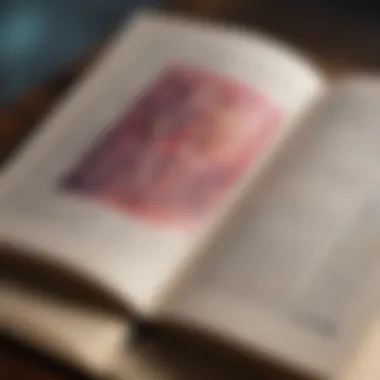Exploring Literature on Sexuality: Insights and Themes


Intro
Literature, in all its forms, serves as a mirror reflecting the complexities of human experience. When it comes to sexuality, this lens becomes even more intricate, revealing layers of identity, relationships, and societal norms. In this guide, we will journey through various works that engage with the many dimensions of sexuality, providing insights that might just resonate on a personal level while prompting a broader understanding of society's intricate tapestry.
Understanding sexuality goes beyond just the act itself; it involves an exploration of identity, health, and the dynamics of relationships. These elements are artfully interwoven in a myriad of literary works — from ancient texts to contemporary narratives. This exploration acts not merely as an academic interest but as a vital tool for personal and collective enlightenment.
Through examining key concepts and insights, related literature, and further resources, this article endeavors to equip readers — whether students, professionals, or educators — with knowledge and perspectives that can inform their understanding of sexuality and its vast landscape.
Prelude to Sexuality and Literature
The intersection of sexuality and literature is a fascinating realm, rich with nuances and complexities that illuminate how we understand human desires, identities, and relationships. Consequently, this topic is not just a passing fad in contemporary discourse; rather, it embodies a profound exploration into the many layers of human experience. Literature serves as a mirror to society, reflecting the myriad ways in which sexuality is conceived, expressed, and sometimes suppressed.
In this guide, we will delve into various facets of sexuality as expressed through literature, emphasizing that sexuality is not merely a biological impulse, but a deeply embedded aspect of our social fabric. By engaging with these texts, we learn about ourselves and the societies we inhabit, fostering greater empathy and understanding of others.
Moreover, grappling with literature that tackles themes of sexuality can be enlightening for individuals seeking to explore their own identities. This journey of self-discovery can often lead to personal growth and healthier relationships. In a world where conversations about sexuality can be fraught with discomfort, literature often serves as a comforting cushion, softening the blow of harsher realities. This exploration can help strip away stigma surrounding discussions on sexual health, orientation, and identity.
As we embark on this exploration, it's crucial to recognize not only the diverse perspectives these texts bring but also the historical contexts that shape their narratives. Whether it's historical accounts that highlight shifts in societal norms or contemporary works challenging existing paradigms, understanding these narratives is integral to appreciating the evolution of sexual discourse.
Defining Sexuality
Sexuality is often viewed through a narrow lens, typically confined to physical acts or orientations. However, it encompasses a much broader spectrum, involving emotional, psychological, and cultural dimensions. Each dimension contributes to the way individuals experience their own sexuality. For instance, a person's sexual orientation might influence their emotional connections, and vice versa. Additionally, cultural backgrounds play a pivotal role; what is deemed acceptable in one culture might be shunned in another.
Sexuality also involves identity – how individuals perceive and label themselves and others. Terms like heterosexual, homosexual, bisexual, and asexual sit atop a vast range of identities that evolve over time. The changing language surrounding these identities reflects broader societal shifts, often challenging outdated stereotypes and norms. A deep dive into literature reveals how these identities are portrayed, scrutinized, or celebrated across genres, fostering a more nuanced understanding of the complexities of human sexuality.
The Role of Literature in Understanding Sexuality
Literature holds a significant place in shaping our understanding of sexuality. Through narratives and diverse character experiences, readers can engage with different aspects of sexuality that are often left underexplored in everyday discourse. Fiction and poetry alike introspectively present feelings, desires, and conflicts in a manner that resonates with both personal and collective human experiences. This engagement allows readers to not only conceptualize but also empathize with viewpoints distinct from their own.
Moreover, literature often brings to light societal issues concerning sexuality – including representation, accessibility, and health. It serves as a vehicle for marginalized voices advocating for recognition and rights, consequently influencing public perception and policy. When authors bravely pen their truths about their sexual identities and experiences, they pave the way for a broader, more inclusive dialogue that can effect change.
In summary, literature is more than just an articulation of words; it’s a powerful tool for deciphering the myriad layers surrounding sexuality. By acknowledging and engaging with this wealth of literature, readers can foster a more profound understanding – both of themselves and of the heavy tapestry of sexuality interwoven into the human experience.
"Literature can sometimes be a bridge from the isolated world of personal experience to a communal understanding of our shared humanity."
Engaging with texts on sexuality opens avenues for dialogue on topics that might otherwise go unaddressed, pushing the boundaries of social norms and encouraging a continual evolution in thought and understanding.
Historical Perspectives on Sexuality
Exploring historical perspectives on sexuality is vital for grasping how sexual norms and values have evolved over the centuries. By examining the past, we gain insights into contemporary issues surrounding identity, health, and relationships. Literature serves as a mirror reflecting societal attitudes, providing context to our current understanding. By delving into historical texts, we uncover not only the expressions of sexuality but also the cultural, religious, and political influences that shaped those narratives. This section will explore how ancient texts and Renaissance literature contribute to the ongoing dialogue about sexuality.
Sexuality in Ancient Texts
Ancient literature offers a rich tapestry of themes related to sexuality, revealing how different cultures understood and articulated complex emotional and physical experiences. The texts from this period show a diversity of sexual behaviors and social norms, which can often surprise modern readers.
Mesopotamian Myths
In Mesopotamian myths, the explicit incorporation of sexuality plays a pivotal role in storytelling. The Epic of Gilgamesh, for example, weaves themes of love, desire, and mortality into its narrative, reflecting a society where the divine and human realms intersect intimately. One key characteristic of these myths is their benevolent approach to sexuality as a natural element of life, challenging the often restrictive views in later cultures. The unique feature of Mesopotamian myths lies in their blend of spirituality and sensuality, making them a beneficial choice for understanding early human sexuality. However, the interpretations can sometimes be complex, requiring careful analysis to appreciate their depth.
Greek Tragedies
Greek tragedies present a nuanced exploration of sexual themes, particularly in the context of fate and personal agency. Consider works like Euripides' "The Bacchae", which depict the tension between societal norms and primal desires. The raw emotion expressed through characters' sexual encounters highlights the human condition's complexity, making Greek tragedies an irreplaceable asset when examining sexual discourse in literature. The key characteristic of these works is their tragic exploration of desire's consequences, drawing readers into moral and ethical dilemmas. However, their darker tones can also pose challenges, potentially overwhelming less experienced readers.
Roman Literature
Roman literature marked a critical evolution in the portrayal of sexuality, blending eroticism with philosophical inquiry. Authors such as Ovid and Catullus explored not only love and lust but also the societal institutions surrounding them. A distinctive aspect of Roman texts is their candidness, showcasing a spectrum of relationships and sexual practices in a manner that is frequently unrepentant. This openness allows readers to confront taboo subjects directly, making Roman literature an enduring choice for discussions about sexuality. Nevertheless, this same frankness can raise questions about morality and ethics, making it simultaneously enriching and provocative.
Evolution of Sexual Discourse in the Renaissance


The Renaissance period was a turning point in the development of sexual discourse. It fostered an environment where sexuality was discussed more openly compared to previous eras. Writers began to challenge the restraints imposed by the church and societal expectations, leading to a rich dialogue surrounding sexual identity and expression. This epoch not only produced significant literary works but also set the stage for modern discussions about sexual rights and education. Through the lens of Renaissance literature, we observe an important pivot in how sexuality becomes a subject of both critique and celebration.
Modern Literature on Sexuality
Exploring modern literature on sexuality is crucial for understanding the evolving landscape of sexual identity, attitudes, and norms. This body of work reflects societal shifts and challenges surrounding sexuality, offering both personal narratives and broader social commentaries. As times change, literature serves as a mirror, capturing the complexities and nuances of human sexuality that many are grappling with. The narratives we engage with today are not just stories; they’re pathways to empathy and understanding, vital for forging connections across diverse communities.
Contemporary Voices and Perspectives
Contemporary literature about sexuality thrives on amplifying diverse voices and perspectives, many of which have been marginalized or overlooked in the past. This segment is vital in addressing the myriad experiences that shape sexual identities and relationships today.
Marginalized Perspectives
Marginalized perspectives in modern literature bring to light the voices of those often sidelined in mainstream discourse, including LGBTQ+ individuals, people of color, and those with disabilities. These narratives enrich our understanding of sexuality by presenting experiences that challenge dominant narratives and slash through stereotypes.
The key characteristic of this approach is its authenticity; it provides an honest portrayal of lived experiences, often embedded in cultural contexts that differ significantly from the dominant narratives. By placing these voices front and center, literature helps to combat ignorance and promote inclusivity, making it a beneficial choice for this article.
One unique feature of marginalized perspectives is their reliance on storytelling as a tool for advocacy. Authors often weave their lived realities into their narratives, which can offer profound insights into intersectional identities. This characteristic not only fosters a sense of community but also initiates conversations about privilege and oppression. However, the representation may sometimes be challenging to navigate due to societal biases, limiting audiences’ openness to these vital stories.
Queer Literature
Queer literature is another essential aspect of contemporary writing on sexuality, dealing with a myriad of themes surrounding queer identities, relationships, and experiences. In this genre, fluidity often takes center stage, reflecting the dynamic nature of sexual and gender identities.
The resonance of queer literature lies in its ability to evoke a sense of belonging among readers who identify as LGBTQ+, making it a valuable asset to this exploration. A distinctive feature is the focus on love, desire, and identity that challenges traditional heteronormative narratives, paving the way for broader acceptance.
Moreover, queer literature frequently employs satire, humor, and candidness, enriching its appeal. While this genre leads to a stronger sense of community and understanding, there can be misunderstandings from those outside the community, which might hinder its accessibility and acceptance.
Feminist Texts
Feminist texts present another critical viewpoint within modern literature on sexuality. These works explore themes of power, autonomy, and societal expectations surrounding gender and sexuality, offering a critique of patriarchal structures that dictate sexual norms.
The defining characteristic of feminist literature is its advocacy for agency and equality, often employing a lens that scrutinizes the impact of gender on sexual expression. Such texts contribute to the overall goal of this article by questioning oppressive norms and advocating for a more equitable society.
A unique feature of feminist texts is their focus on intersectionality, revealing how race, class, and sexuality intertwine to shape experiences. While these works can provoke critical discussions about privilege and representation, they may also encounter resistance from those who feel threatened by challenging traditional roles in society.
Sexuality Within Fiction and Poetry
Transitioning to the way sexuality is depicted in fiction and poetry, we can see how these artistic forms capture the essence of human experiences. Fiction offers narrative depth, allowing exploration of characters' inner lives and emotional landscapes. Through poetry, the rawness and immediacy of feelings concerning love, desire, and sexuality take form, often in metaphors that resonate deeply with human experiences. Both mediums facilitate a dialogue on sexuality that is both personal and societal, rich in insight and understanding.
Sexual Health and Education Literature
Sexual health and education literature plays a crucial role in shaping our understanding of sexuality through diverse frameworks. This area of literature encompasses a wide range of topics, from basic anatomy and reproductive health to discussions about consent, relationships, and emotional well-being. Engaging with this literature not only enhances individual knowledge but also fosters more informed communities regarding sexual health. The ripple effect of such literature can be profound, influencing societal norms and personal behaviors related to sexuality.
In a world where misinformation can easily spread, particularly through social media, having reliable and comprehensive resources becomes even more important. A strong grasp of sexual health literacy empowers individuals to make informed decisions, seek appropriate services, and advocate for their own health. Therefore, exploring sexual health and education literature is an essential step in ensuring a well-rounded understanding of sexuality and its implications.
Importance of Sexual Health Literacy
Sexual health literacy refers to the skills one requires to obtain, process, and understand basic sexual health concepts. It's not just about knowing the mechanics of sex; it's about understanding the context in which sexual activity takes place. Adequate sexual health literacy has several key benefits:
- Informed Decision-Making: It equips individuals with the knowledge to make sound choices on personal relationships and sexual practices.
- Enhanced Communication: With proper understanding, discussing sexual health becomes easier, reducing stigma and anxiety.
- Empowerment: Knowledge fosters confidence, allowing individuals to advocate for their health and seek help when needed.
Ultimately, knowing how to navigate sexual health literature can build healthier relationships and contribute to positive sexual experiences. Without this knowledge, there's a risk of misinformation leading to adverse health outcomes, both physically and emotionally.
Books on Sexual Health and Well-Being
A variety of books focus on sexual health and well-being, offering a comprehensive look into this crucial aspect of literature. Some notable titles include:
- "The Joy of Sex" by Alex Comfort: A classic that provides straightforward, yet informative guidance about sexual practices and emotional connections.
- "Come as You Are" by Emily Nagoski: This book examines the science of sexuality, addressing how various factors influence sexual functioning and pleasure, appealing to many personal experiences.
- "Sexual Intelligence" by Marty Klein: Delving into how our emotions interplay with our sexual lives, Klein brings a unique perspective on being mindful and aware in intimate situations.


In addition to individual authors, many anthologies encompass a broad spectrum of voices and experiences, providing valuable insights into both historical and contemporary discussions about sexual health. Connecting with this literature ensures readers stay informed and engaged with ongoing conversations about well-being, consent, and personal agency.
"Education is the most powerful weapon which you can use to change the world." - Nelson Mandela
Through reading and understanding sexual health and education literature, individuals can cultivate knowledge that transcends mere facts – knowledge that can lead to real-life changes in health perceptions and practices. Promoting such resources fosters a healthier society overall, one where conversations surrounding sexuality are open and informed.
Sexual Identity and Intersectionality
Understanding sexual identity and intersectionality is paramount in the realm of literature. This topic not only lays the groundwork for our understanding of sexuality itself but also frames it within the broader social and cultural contexts that shape it. When exploring sexual identity, we can’t turn a blind eye to the layers of race, class, gender, and other factors that influence how individuals experience and express their sexuality. This multidimensional perspective enables us to appreciate the complexities involved in sexual identity, as well as the shared and unique struggles of various marginalized groups.
The importance of acknowledging intersectionality in sexual identity is rooted in realistic representations of human experiences. Readers are presented with a more authentic narrative when authors highlight these complexities. For instance, a work that explores the experiences of a Black gay man provides insights distinct from those of a white gay man, largely due to the interplay of race and sexuality. Such literature opens windows to emotional landscapes that encompass both personal and societal challenges, adding depth to the discussion surrounding sexual identity.
Additionally, literature about sexual identity enables individuals to find solace and understanding in their own experiences. It empowers conversations that break the silence around issues of discrimination and privilege, helping readers to navigate their own identities in a clearer context. Books and articles that discuss intersectionality in sexual identity invite readers to examine not only their own positions in society but also that of others, fostering empathy and awareness.
Intersection of Sexuality and Race
The intersection of sexuality and race is a crucial element of understanding how various identities are constructed and expressed in literature. When discussing this topic, one must consider how different racial contexts can significantly alter the way individuals perceive both their own sexuality and the sexuality of others.
Historical narratives often overshadow the experiences of people of color in discussions about sexuality. However, contemporary authors are increasingly breaking this mold. For example, in the writings of Audre Lorde, we witness a powerful fusion of race, gender, and sexuality. Her work underscores how these elements are interlinked, creating unique challenges and rich perspectives. Similarly, recent novels like "The Color Purple" by Alice Walker give voice to the struggles of Black women in navigating both racism and sexual identity, celebrating the resilience that emerges from these intersecting experiences.
A few key points to consider:
- Cultural Context: Different cultures have distinct beliefs and practices associated with sexuality, which can affect how individuals relate to their sexual identity.
- Social Pressures: Individuals from racial minorities often face additional pressure from within their communities regarding the acceptance of their sexual identities. For instance, a Latino individual may grapple with familial expectations while trying to embrace their queer identity, highlighting the need for literature that explores these tensions.
- Visibility and Representation: The need for literature that reflects the lived experiences of people of color cannot be overstated. When marginalized voices are portrayed accurately, it paves the way for social understanding and change.
Gender Identity in Literature
Gender identity in literature presents another layer of understanding within the intersectionality framework. Authors delve into gender norms and expectations, often reflecting the complexities of personal and societal influences on gender expression and identity.
In many literary works, characters embody fluidity in their gender identity, pushing the boundaries of what society traditionally accepts. For instance, the works of Virginia Woolf often grapple with and blur the lines between male and female identity, allowing readers to question preconceived notions of gender.
Books like "Gender Trouble" by Judith Butler challenge binary classifications and suggest that gender is performative. This argument invites readers to consider how gender is not merely a label but a complex interplay of identity and social constructs. Moreover, literature that presents diverse gender identities highlights the experiences of those who exist outside traditional paradigms. This serves not just to inform but also to advocate for authenticity and acceptance.
Strategies for embracing the theme of gender identity in literature include:
- Encouraging Dialogue: Literature can act as a vehicle for discourse on gender identity, breaking down barriers and fostering connections.
- Exploring Diverse Characters: Creating multifaceted characters helps dismantle stereotypes and opens avenues for deeper understanding and growth.
- Reflecting Real-Life Experiences: By portraying real struggles and victories, authors contribute to a broader societal change that is necessary in promoting inclusivity.
Ultimately, discussions of sexual identity and intersectionality in literature not only shape public opinion but also have profound implications for personal understanding. They challenge existing power structures and empower diverse voices, making the realm of sexuality more inclusive and representative.
The Impact of Literature on Social Change
Literature has always served as a mirror reflecting societal values, struggles, and aspirations. When we specifically dwell into the domain of sexuality, it becomes clear how profoundly literature can shape, challenge, and reform public perceptions. Books, poems, essays, and plays act not just as vehicles of storytelling but also as platforms for raising awareness, igniting conversations, and fostering empathy towards diverse sexual identities and experiences.
By exploring themes of sexuality, works of literature can become a bridge connecting readers to previously unexamined lives and viewpoints. This engagement encourages readers to rethink stereotypes and biases, laying the groundwork for social change. Literature not only documents the nuances of human sexuality but also provides a space for dialogue, which is often essential for societal growth and acceptance.
Shaping Public Perception
When discussing public perception, the influence of literature cannot be understated. For instance, works like The Color Purple by Alice Walker and And Tango Makes Three by Justin Richardson and Peter Parnell have sparked significant discussions about race, gender, and sexual orientation, respectively.
These narratives provide readers with a window into lives they might not be familiar with, fostering understanding and empathy. Here are some ways literature shapes public perception on sexuality:
- Creating Awareness: Books and narratives expose societal issues surrounding sexual identity and rights, drawing attention to the struggles faced by marginalized communities.
- Challenging Norms: Authors push against established norms, presenting alternative views on love, relationships, and desire that challenge the conventional discourse.
- Empathy Building: Through compelling storytelling, readers find themselves relating to characters whose experiences may be vastly different from their own, leading to greater emotional understanding.
As readers immerse themselves in these texts, their perspectives often broaden, leading to a more nuanced understanding of identity and the complexities of human emotions.
Literature as a Catalyst for Policy Change
It's fascinating to note how literature doesn't merely reflect society; it also has the power to instigate changes in policy. Written works can influence legislation and political discourse regarding sexual health and rights.


Consider Silent Spring by Rachel Carson, which, although focused on environmental issues, opened up discussions about public health that intersect with sexual health and rights. Specifically, this type of literature can lead to:
- Legislative Advocacy: Authors often use their words to highlight the need for policy reform, encouraging advocacy for LGBTQ+ rights and sexual health education in curricula.
- Public Campaigns: Literature can inspire movements that push for changes in public policy, particularly regarding health care access, anti-discrimination laws, and education on sexual health.
- Building Coalitions: Writers and activists can come together through literature to form powerful alliances, pushing for social changes that address entrenched issues.
In summary, literature is more than just a collection of words on a page; it holds the potential to inspire a generation. By shaping public perception and acting as a catalyst for policy change, it provides a crucial framework for understanding the complex landscape of sexuality and its impact on society.
"Literature is the most effective weapon against ignorance and oppression."
Through these diverse contributions, literature continues to play a vital role in our ongoing dialogue about sexuality, helping to pave the way for meaningful social change.
Challenges and Critiques in Sexuality Literature
The exploration of sexuality in literature is complex and multifaceted. While literature has the power to shape our understanding of sexual identity, health, and relationships, it is not without its share of challenges and critiques. These obstacles often stem from societal standards, individual biases, and the evolving nature of gender and sexuality discussions. Understanding these challenges enhances literacy regarding sexuality, providing readers with tools to better navigate the narratives they encounter.
Key Challenges in Sexuality Literature:
- Censorship: Certain texts face challenges due to censorship influenced by cultural, religious, or political beliefs. This can hinder access to important narratives that contribute to awareness and understanding.
- Outdated Perspectives: Some sexual education literature relies on outdated views that fail to capture the modern complexities of gender and identity. These texts can perpetuate harmful stereotypes and myths.
- Resistance to Diversity: Literature often mirrors societal prejudices. Works that represent marginalized voices may struggle for visibility and acceptance, leading to a limited narrative in mainstream discussions.
Addressing these challenges is crucial because they can prevent the growth of a well-rounded discourse on sexuality. It is vital for readers to engage with various texts, critically analyzing their messages. Only then can they contribute thoughtfully to conversations surrounding sexuality.
Critiquing Sex Education Literature
Sex education literature has often been the backbone of many discussions surrounding sexuality. It serves as a guiding tool for young audiences. However, critiques often focus on content shortcomings, delivery methods, and evolving societal norms.
One dominant critique revolves around the notion that many sex education texts are either overly simplistic or horrifically graphic, failing to balance the two extremes effectively. Tailoring these texts for varying age groups can be a peculiar task. Texts should ideally convey essential information without crossing into discomforting territory.
Also, the representation of non-binary experiences and LGBTQ+ narratives frequently takes a backseat in traditional discussions. Outdated sex education literature tends to focus primarily on heterosexual relationships, leaving readers from diverse backgrounds feeling excluded.
"Sex education goes beyond anatomy and physiological components. It should encompass emotional intelligence and respect for diverse identities."
Newer texts prioritizing inclusivity and authenticity provide a better foundation but may struggle in more conservative or traditional environments. Readers should always question whether the resources they engage with provide comprehensive, respectful, and truthful representations of sexuality. Understanding the nuances behind these critiques elevates readers' perspectives.
Representation and Visibility Issues
Representation in literature is an ongoing discussion that encompasses many aspects, especially around sexual identities. The visibility of LGBTQ+ authors, characters, and narratives is vital for fostering understanding and acceptance. Unfortunately, many texts still struggle with adequately depicting diverse experiences.
Factors contributing to lack of representation:
- Stereotypes: Many authors unwittingly reinforce clichés that fail to represent the complexity of human experiences. This can lead to one-dimensional characters, which can be detrimental to both the audience’s understanding and the subjects portrayed.
- Limited Narratives: A preoccupation with certain types of stories often results in a narrow viewpoint, sidelining the profound multiplicity of sexual experiences across different cultures.
- Commercial Pressures: Publishers may prioritize stories that align with mainstream narratives, stifling innovative voices from minority groups.
In light of these issues, emphasizing representation becomes crucial. When readers encounter diverse sexual identities in literature, it aids in cultivating empathy and broadened horizons. Efforts are underway to discover and amplify texts that reflect the rich tapestry of lived experiences concerning sexuality.
To summarize, a critical engagement with sexuality literature is essential. Through identifying challenges and advocating for inclusive representation, readers can establish a more profound understanding, ultimately enriching their perspective on the myriad realities of human sexuality.
Ending: The Ongoing Dialogue of Sexuality in Literature
In the vast landscape of literature, sexuality occupies a distinctive and pivotal space. The ongoing dialogue surrounding sexuality reflects changing societal attitudes, individual experiences, and the evolution of cultural norms. This article has navigated through various literary works, revealing how they contribute significantly to our understanding of sexual identity, health, and relationships.
The relationship between literature and sexuality is not a mere academic pursuit; it serves a profound purpose in the real world. When works of literature address sexual topics, they lay bare the complexities of human emotions and relationships. This act of opening doors to conversations about sexuality allows for greater awareness and empathy, prompting readers to examine their beliefs and attitudes. Furthermore, literature can sometimes challenge societal taboos, forcing a dialogue that may lead to policy reforms and a shift in public perception.
The Importance of Ongoing Conversations
Literature’s role in shaping discussions about sexuality is crucial for several reasons:
- Fostering Understanding: By presenting diverse experiences and perspectives, literature enhances our understanding of various sexual identities — helping to dismantle stereotypes and prejudices.
- Building Empathy: Stories that dive into the intimate lives of characters allow readers to connect emotionally, thereby creating a bridge to understanding others’ struggles and triumphs.
- Encouraging Inquiry: Engaging with texts that challenge the norm compels readers to question their assumptions and engage in critical thinking regarding their own and others’ sexualities.
- Creating Space for Marginalized Voices: Literature provides a platform for voices often left unheard — those from LGBTQ+ communities, women, and people of color — nurturing a broader and richer dialogue.
As we look to the future, the dialogue surrounding sexuality in literature is likely to become more vibrant and significant. The rise of self-published works and digital storytelling has already begun to democratize the literary space, allowing a multitude of voices to be heard. This increased representation will likely lead to more nuanced discussions and insights into sexuality, as emerging writers share their fresh perspectives.
"Literature is the mirror of society; it reflects our struggles, desires, and the paths we tread to understand ourselves."
The Future of Sexuality Literature
The future of sexuality literature is promising — yet it also poses several challenges and considerations:
- Increased Diversity: We can expect a continued influx of diverse voices in the conversation about sexuality. New authors will bring unique experiences that enrich the topic.
- Digital Narratives: Technology will play a crucial role, with digital platforms allowing for the exploration of sexuality through interactive storytelling and multimedia formats.
- Shifting Norms: As societal norms evolve, so too will the narratives surrounding sexuality. What remains taboo today may inspire a new generation of storytellers.
- Educational Integration: We may witness more literature integrated into educational curricula, enhancing sexual health education in schools.
- Global Perspectives: The exchange of cultural narratives promises to further broaden the understanding of what sexuality means across different societies.







